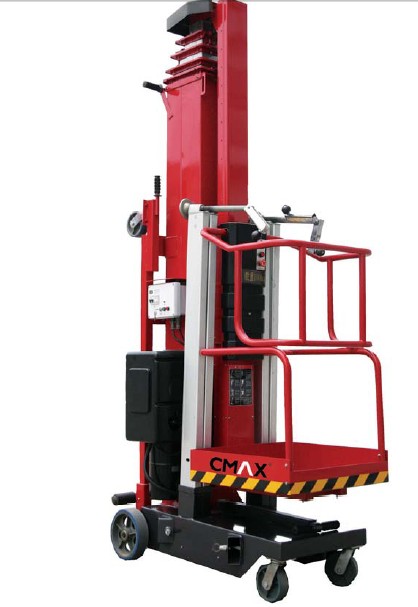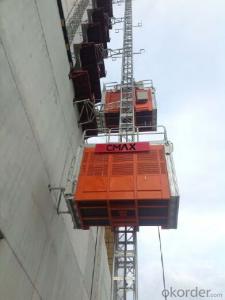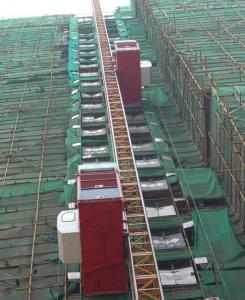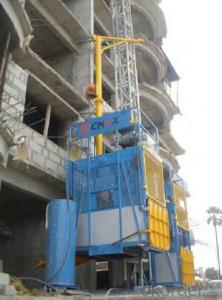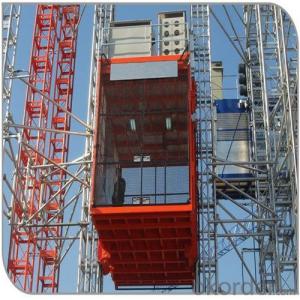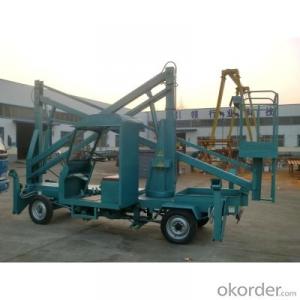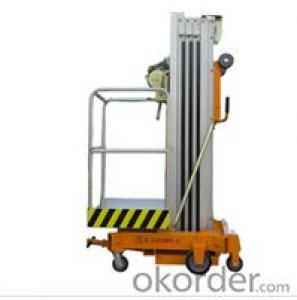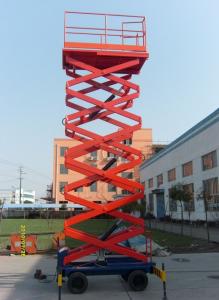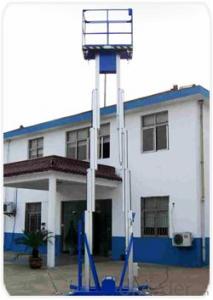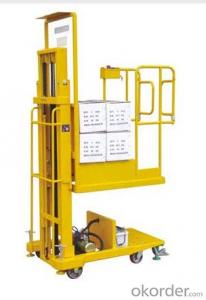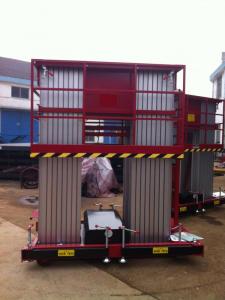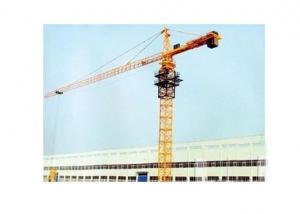Aerial Work Platform
- Loading Port:
- China Main Port
- Payment Terms:
- TT or L/C
- Min Order Qty:
- 4 Sets m.t.
- Supply Capability:
- 30 Sets Per Month m.t./month
OKorder Service Pledge
OKorder Financial Service
You Might Also Like
GTWY series aerial working platform
It is made of high strength stainless steel sleeve mast. High polymer sliding blocks are used
between sleeves to ensure close connection and flexible movement to improve work stability. GTWY is compact, light, conveniently
moved, and also with large working height and high reliability.
GTWY Aerial work plaftform application
generally used for temporary, flexible access purposes such as maintenance and construction work or by firefighters
for emergency access, which distinguishes them from permanent access equipment such as elevators. They are designed to lift limited
weights — usually less than a ton, although some have a higher safe working load — distinguishing them from most types of cranes
. They are usually capable of being set up and operated by a single person.
Work plaftform specifications
Max. working height(m): 16
Travelling when lifts(kg): 8100(12 boom)
Max. lifting torque(kN m): 2062
Boom length: 12~30(standard configuration 18m)
Working range: 4~29(outriggers extended)
Elevation range: 22~77
Max. lifting height(mm): 27650 (with 30 boom)
Axle base(mm): 2650+1300
Wheel base fromt/rear(mm): 2400/2400
Ground clearance(mm):225
Gradeability(%):21
Min. turning diameter(m): 20
GVW(with 12m boom)(kg): 49700
Outigger type: H type

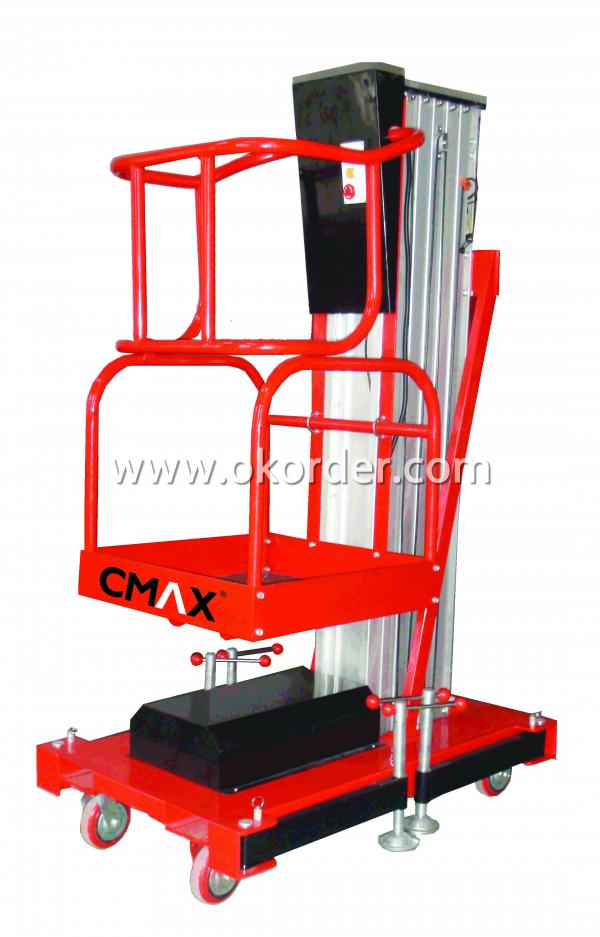
- Q: This question asks if a building hoist is capable of repeatedly lifting and lowering objects.
- <p>Yes, a building hoist is specifically designed for lifting and lowering objects repeatedly. It is a type of crane used in construction to move materials vertically. The hoist is engineered to handle multiple cycles of lifting and lowering, making it an essential tool for efficient construction work. It is equipped with a motor and a system of pulleys or gears that enable it to perform these tasks safely and effectively, as long as it is properly maintained and operated according to its specifications.</p>
- Q: This question asks for the method to determine the maximum weight that a building hoist can safely lift.
- <p>To calculate the lifting capacity of a building hoist, you need to consider several factors. First, identify the hoist's rated capacity, which is usually specified by the manufacturer. This is the maximum weight the hoist is designed to lift. Next, assess the condition of the hoist, including any wear and tear that might affect its performance. Check the hoist's mechanical components, such as cables, pulleys, and motors, to ensure they are in good working order. Additionally, consider the weight of the load you intend to lift and any additional factors like the frequency of lifts or the height of the lift. Always operate within the hoist's rated capacity and follow safety guidelines to prevent accidents.</p>
- Q: Is it possible for non-professionals to overhaul or repair a hydraulic cylinder in a building hoist?
- <p>No, a hydraulic cylinder in a building hoist should not be overhauled or repaired by non-professionals. Hydraulic systems are complex and require specialized knowledge and skills to service. Attempting repairs without proper training can lead to serious safety hazards, equipment damage, and potential accidents. It is crucial to have a qualified technician or professional mechanic handle any maintenance or repairs to ensure safety and compliance with industry standards.</p>
- Q: What's going on with the decline in construction lift
- Check whether the brake work is valid.Check to see if there is any problem with holding the brake.
- Q: This question asks about the various elements that can influence the efficiency and effectiveness of a building hoist.
- <p>The performance of a building hoist is affected by several factors including the type and weight of materials being lifted, the frequency of use, the hoist's mechanical condition and maintenance, environmental conditions such as wind and temperature, the skill and training of operators, and the design and capacity of the hoist itself. Proper installation, regular inspections, and adherence to safety protocols also play a crucial role in ensuring optimal performance and safety. Additionally, the quality of electrical systems, the efficiency of the drive mechanism, and the structural integrity of the hoist's components can significantly impact its operation.</p>
- Q: This question asks whether a building hoist can be utilized in construction or demolition activities.
- <p>Yes, a building hoist can be used for both construction and demolition work. In construction, hoists are essential for transporting materials and personnel vertically within a building under construction. They are designed to handle heavy loads and operate safely at significant heights. In demolition, hoists can be used to remove debris and transport workers to different levels of a structure being dismantled. However, it's crucial to ensure that the hoist is suitable for the specific task and that all safety protocols are followed to prevent accidents.</p>
- Q: Identify the elements that influence the durability and operational lifespan of lifting machinery, specifically focusing on Building Hoists.
- <p>The lifespan of lifting equipment, including Building Hoists, is influenced by several factors: 1) Material Quality: The type and quality of materials used in construction directly affect durability and resistance to wear and tear. 2) Design and Engineering: Proper design ensures optimal performance and reduces stress on components. 3) Frequency of Use: More frequent use can lead to faster wear and tear. 4) Maintenance and Repair: Regular maintenance can extend the lifespan, while neglect can shorten it. 5) Operating Conditions: Environmental factors such as temperature, humidity, and exposure to corrosive substances can impact longevity. 6) Load Capacity: Overloading can cause premature failure. 7) Compliance with Safety Standards: Adhering to safety guidelines can prevent accidents and damage. 8) Technological Advancements: Newer models may have improved features that extend lifespan.</p>
- Q: This question asks about the measures taken to ensure that lifting equipment remains safe and functional in various weather conditions.
- <p>To ensure that lifting equipment is safe and reliable in all weather conditions, regular maintenance and inspection are crucial. Equipment should be designed with weather-resistant materials and should be tested periodically to withstand extreme temperatures, humidity, and precipitation. Protective covers or enclosures can be used to shield equipment from the elements. Additionally, training operators on the safe use of equipment in different weather conditions is essential. Emergency procedures should be in place for extreme weather events, and equipment should be regularly checked for wear and tear that could be exacerbated by weather conditions.</p>
- Q: Is it possible to fix or replace a building hoist once it has stopped functioning?
- <p>Yes, a building hoist can be repaired or replaced after it has failed. Repairs are often possible if the hoist has mechanical or electrical issues that can be diagnosed and fixed by a qualified technician. If the hoist is beyond repair or if it's more cost-effective, a replacement may be necessary. It's crucial to have a maintenance plan and regular inspections to prevent failures and ensure the hoist's safe operation. In case of a failure, immediate action should be taken to either repair the existing hoist or install a new one, adhering to safety standards and regulations.</p>
- Q: How many meters is the wall of the construction elevator?
- It seems that there is no, just the local code, you search for the construction elevator acceptance specification look, I have searched this aspect before, now forget.
Send your message to us
Aerial Work Platform
- Loading Port:
- China Main Port
- Payment Terms:
- TT or L/C
- Min Order Qty:
- 4 Sets m.t.
- Supply Capability:
- 30 Sets Per Month m.t./month
OKorder Service Pledge
OKorder Financial Service
Similar products
Hot products
Hot Searches
Related keywords





